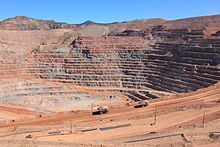Our website is made possible by displaying online advertisements to our visitors.
Please consider supporting us by disabling your ad blocker.
Porphyry copper deposit


Porphyry copper deposits are copper ore bodies that are formed from hydrothermal fluids that originate from a voluminous magma chamber several kilometers below the deposit itself. Predating or associated with those fluids are vertical dikes of porphyritic intrusive rocks from which this deposit type derives its name. In later stages, circulating meteoric fluids may interact with the magmatic fluids. Successive envelopes of hydrothermal alteration typically enclose a core of disseminated ore minerals in often stockwork-forming hairline fractures and veins. Because of their large volume, porphyry orebodies can be economic from copper concentrations as low as 0.15% copper and can have economic amounts of by-products such as molybdenum, silver, and gold. In some mines, those metals are the main product.
The first mining of low-grade copper porphyry deposits from large open pits coincided roughly with the introduction of steam shovels, the construction of railroads, and a surge in market demand near the start of the 20th century. Some mines exploit porphyry deposits that contain sufficient gold or molybdenum, but little or no copper.
Porphyry copper deposits are currently the largest source of copper ore.[1] Most of the known porphyry deposits are concentrated in: western South and North America and Southeast Asia and Oceania – along the Pacific Ring of Fire; the Caribbean; southern central Europe and the area around eastern Turkey; scattered areas in China, the Mideast, Russia, and the CIS states; and eastern Australia.[2][3] Only a few are identified in Africa, in Namibia[4] and Zambia;[5] none are known in Antarctica. The greatest concentration of the largest copper porphyry deposits is in northern Chile. Almost all mines exploiting large porphyry deposits produce from open pits.
- ^ John, D. A.; Taylor, R. D. (2016). "Chapter 7: By-Products of Porphyry Copper and Molybdenum Deposits". In Philip L. Verplanck and Murray W. Hitzman (ed.). Rare earth and critical elements in ore deposits. Vol. 18. pp. 137–164. doi:10.5382/Rev.18.07.
- ^ "Archived copy" (PDF). Archived from the original (PDF) on 2009-05-10. Retrieved 2009-08-31.
{{cite web}}: CS1 maint: archived copy as title (link) - ^ Base Metals Archived 2008-06-02 at the Wayback Machine
- ^ Base Metals Archived 2008-06-02 at the Wayback Machine
- ^ "Archived copy" (PDF). www.mawsonwest.com.au. Archived from the original (PDF) on 7 March 2010. Retrieved 12 January 2022.
{{cite web}}: CS1 maint: archived copy as title (link)
Previous Page Next Page


